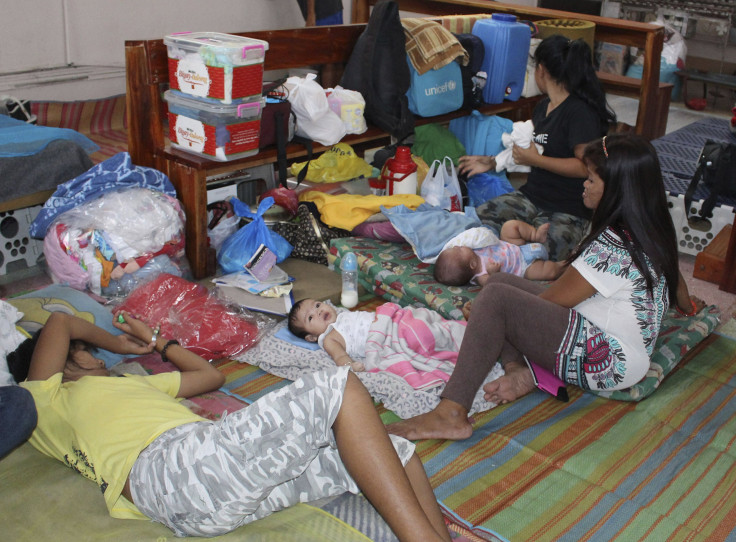Homes Flattened As Typhoon Roars Through Philippines

(Reuters) -- A powerful, slow-moving typhoon ripped through the central Philippines Sunday, bringing howling winds that flattened houses and toppled trees and power lines in areas still scarred from a deadly superstorm just over a year ago.
In the coastal villages of Dolores, on Samar island, where Typhoon Hagupit made landfall Saturday night, Mayor Emiliana Villacarillo said around 80 percent of homes were destroyed. “Only the big houses were left standing,” said Villacarillo, who added that floods washed away rice crops in what is a key growing region.
Officials confirmed at least three people died due to the typhoon, including a resident of Dolores town who was killed by a falling coconut tree. “The devastation in homes is huge because of the strong winds,” Interior Secretary Manuel Roxas told local radio DzBB from Samar. “Many people voluntarily returned to evacuation centers tonight, even more than those who fled to centers last night, because they do not have homes anymore.”
But Hagupit did not appear to have wreaked destruction on the same scale as last year’s super typhoon Haiyan, in part because of a massive operation to evacuate residents from coastal and landslide-prone areas days before the storm hit.
More than 1.2 million people had crowded into more than 1,500 schools, civic centers, town halls, gyms and churches used as evacuation centers across the central Philippines, said Gwendolyn Pang, secretary general of the Philippine Red Cross.
Roxas said rescue teams cleared the highway to Dolores town of about 25 to 30 huge fallen trees. Some residents lined streets asking for food, water and other supplies.
Hagupit, which days earlier had reached Category 5 super-typhoon strength as it churned across the Pacific Ocean, weakened on Sunday to Category 2 as it made a second landfall at Cataingan town in the south of Masbate island. There were no initial reports of the kinds of storm surges that were so destructive during Typhoon Haiyan, which killed more than 7,000 people across the central Philippines.
“Structural damage was caused mostly by wind, not by storm surge,” said presidential representative Abigail Valte.
Power Cut
Power was cut across most of Samar and nearby Leyte province, including Tacloban City, which accounted for about one-half the death toll from Typhoon Haiyan in November last year. Power and communications were also down in Masbate, parts of Cebu island and some southern provinces of the main island Luzon.
The Philippine Long Distance Telephone Co.’s mobile arm, Smart Communications, said about 5 percent of its service area was cut by strong winds. Gen. Gregorio Catapang, head of the military, said nearly 2,000 soldiers were clearing the roads and two airports on Samar to bring in food trucks and aircraft.
The typhoon was crawling west-northwest at 10 kph (6 mph), with sustained winds of 140 kph (86 mph) and gusts of up to 170 kph (105 mph), the Philippine weather bureau Pagasa said.
The weather bureau said Hagupit -- which means “lash” in Filipino -- was following its predicted path through the archipelago's central belt, slightly north of areas devastated by Haiyan last year.
It was hovering 50 kilometers (31 miles) northwest of Masbate City in the center of the island, and was expected to make a third landfall on the small island of Sibuyan early Monday before passing around 120 kilometers south of the capital Manila, Pagasa said.
Tacloban Spared
Alfred Romnualdez, mayor of Tacloban, said although more than 48,000 residents had fled to shelters, damage to the city appeared to have been minor.
“Thank God, the typhoon spared us and we have no reported casualties,” Romualdez told Reuters. “By the end of the day, we expect the people to return to their homes from shelter areas.”
By Sunday evening, people were also returning to their homes from shelters in Leyte island and southern Luzon.
Environmental and humanitarian groups are hoping the typhoon would spur action at the United Nations climate talks in Lima, Peru, where almost 200 nations are meeting to work out an accord to slow global warming, due at a summit in Paris in a year’s time.
“My country is under water, farms have been wiped away, homes destroyed, families separated,” Shubert Ciencia of the Philippine Rural Reconstruction Movement and a member of global relief organization Oxfam, said in Lima.
An Oxfam report in November showed Asia is highly vulnerable to increasingly severe and frequent weather extremes and woefully underprepared to manage growing crises.
(Reporting by Rosemarie Francisco and Manuel Mogato in Manila and Alister Doyle in Lima)
© Copyright Thomson Reuters 2024. All rights reserved.





















